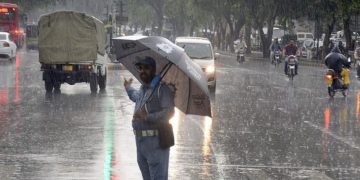Many global challenges are intimidating the sustainability of our water resources leading to water stress and scarcity and therefore impeding our efforts to attain food security. Pakistan could “run dry” by 2025 as its water shortage is reaching a shocking level. The authorities remain negligent about the issue that’s posing a serious threat to the country’s stability.
Water reserves
Pakistan is part of 35 countries that are water-stressed. There are numerous factors and elements that have contributed to the water crisis in the country, such as climate change, an increase in population in urban areas, agriculture and mismanagement of the water system. If the water crisis in Pakistan is not solved, the impact felt by people in the country will worsen.
Pakistan was rich in water resources at the time of its establishment in 1947 and the availability of water here was five thousand cubic meters which have now reduced to a dangerous level of only one thousand cusecs meters.
Impact of the water crisis
Presently, Pakistan is categorized as a water-scarce country because the yearly water availability is less than 1,000 cubic meters per person. In 2005, Pakistan already crossed this level. If it reaches about 600 cubic meters, it will become a country that is completely scarce of water by 2024.
The effect of the water catastrophe in the country is already being felt among citizens. In Pakistan, 82 percent of people living in 25 major metropolises do not have access to clean water. In the slums of the port city Karachi, 17 million do not have access to running water.
Major factors causing the water crisis
Climate Change: The major sources Pakistan gets its water from rivers, rainfall and snow and glaciers melting. Since the rain is seasonal and 90 percent of the country is semi-arid, Pakistan is dependent on the rain for its water delivery.
Pakistan is facing a growing demand for food while it is experiencing a diminution in the water supply. One of the causes that Pakistan will face a rise in water demand could be because of climate transform, which could augment the demand for water for harvests. Climate change could cause the water in the earth to fade faster, which could boost the demand for water.
Population Increase: Pakistan is ranked as the sixth-largest country in the globe with more than 310 million people. Pakistan’s population in 2010 was 179.42 million. Pakistan’s water demand could reach 272 million acre-feet while the supply of water could linger at 191 million-acre-feet by 2025.
Agriculture: The generally grown agriculture crops in Pakistan are extremely dependent on water. The country grows wheat, rice, sugarcane, vegetables and cotton. Crops like these are responsible for 94% of Pakistan’s water use. Poor water management in the country is reasoning high water misuse within the agriculture sector.
Pakistan has an ineffective irrigation system that roots a 59 percent water loss. Additionally, Pakistan has low water efficiency in assessment with other countries. Water output is the material or economic production per unit of water application. Pakistan uses a lot more water to manufacture crops than in other countries.
IMF warning
A report released by the IMF on Pakistan in December last year identified the water crisis in Pakistan as a result of the Indian water aggression and said that Pakistan was ranked the third most water-scarce country in the world.
As a result, it could suffer even more drought and misery than Ethiopia, as drought is extremely deadly to the agricultural sector and without proper planning, the country could face water drought and famine by 2025.
An effective water policy is a need of the hours
Earlier, the government called both national and international Pakistani to assist fund a $15 billion project to build two dams.
The objective of the dam is to assist the country store more water and to supply Pakistan with electricity. Although the nation had donated towards the dam, there is still a lot of money required to complete the projects.
The water issue has been ignored for far too long, and we cannot afford to shelve it any longer. The authorities needed to take positive and concrete steps to slow down the water crisis in the country.
Echoes of Diamer Bhasha Dam and Neelam Jhelum have been heard in Pakistan for 20 consecutive years but none of them has been completed. The Kala Bagh Dam has become a victim of politics in which there is an atmosphere of mistrust between the provinces and this atmosphere is getting worse due to non-acceptance of the position of small provinces.
The shortage of water is also triggering security variances in the country. The economic impact of the water crisis is huge, and the people are fighting for resources. Three out of four Pakistani provinces charge the most packed and politically empowered province, Punjab, for usurping their water sources.
In the years ahead, this could lead to unrest so the authorities need to improve water productivity expand its water storage, prevent India from violating the Indus River Treaty, reduce water waste, and develop an agenda and plans that will help with the management of surface and groundwater.



































